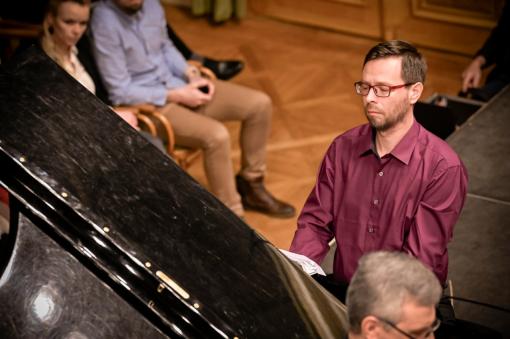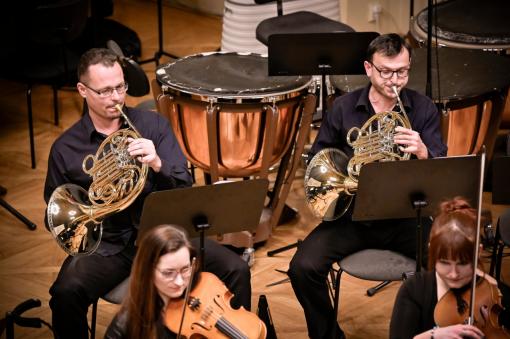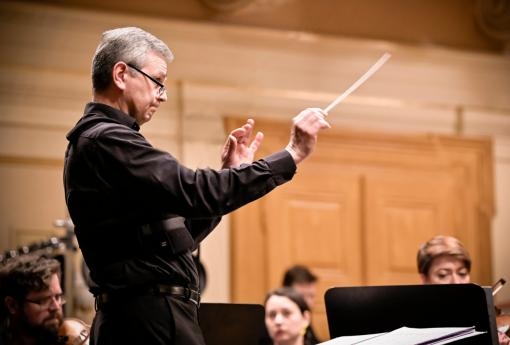The concert with subtitle “Comradeship, Cooperation, Subversion and a Big Battle at the End”, directed by the Brno Contemporary Orchestra (BCO), offered a remarkable programme of contemporary music. It consisted of three Czech and one world premiere, performed at the Besední dům on 27 February under the baton of the tribal conductor Pavel Šnajdr. The choice of the concert hall was anything but random. The Besední dům is celebrating 150 years since its opening this year, and the ensemble held an annual community concert to mark the important anniversary.
The programme opened with Case White by Croatian composer Mirela Ivičević. Originally commissioned by Klangforum Wien in 2019, the piece reflects the struggles of Yugoslav partisans during the World War. The compositional language used in the piece is influenced by the author’s desire to break established rules. In practice, this manifests itself in the search for and combination of diverse sounds, new sonic starting points. However, the integrity of the work is based primarily on emotion or the author’s reflection, which strongly affects the listener. During the performance of the work, one could notice references to fierce struggles, depicted, for example, by percussion and brass instruments. Despite the orchestra’s excellent staging, it was challenging in certain sonically exposed areas to catch all the perceptions and unconventional instrumental and compositional techniques with both hearing and sight.

Concerto for piano and orchestra by Boris Tchaikovsky, Russian composer and student of Shostakovich, accompanied by the Brno Contemporary Orchestra was performed by pianist Stano Slavíček. At first, it seemed that the pianist’s tone was not very expressive, and certain parts (e.g. the decompositions in the counter movement) were not always technically precise. However, given the demanding nature of the piano part, these can be described as minor imperfections. In the lyrical parts, especially in the second movement, the pianist’s flair for exposing subtle melodic phrases was evident. Admirable was the emergence of melody in the upper voices of the piano part, giving these sections a fragility. However, hesitancy and intonational inaccuracies appeared in the violin and double bass sections. These included places in the opening of the piece where the strings match the pianist in unison, and the opening of the second movement with the gradual onset of the double basses, cellos, and piano. However, the musical and interpretative development had an upward tendency, so I can thus describe the overall sound of the piano concerto as very successful.
Unsuk Chin, a South Korean composer living in Berlin, is the author of the three-part composition Graffiti (Palimpsest, Notturno urbano, Passacaglia), which was also performed. The composition is mainly based on work with bells and gongs, where the parts of these instruments crystallize the subsequent musical material with which the composer works. Although the piece has a specific title referring to street art, it is not a descriptive or programmatic composition. But again, we can classify this work as a composition in which we find work with sounds, colours, techniques, etc. Although it is built on contrasting phrases in terms of rhythm, texture and/or rate, the overall impression of the composition (at least musically) is in some ways comparable to the opening piece.

Even today, we encounter a variety of composers’ approaches to the work itself. Some try to search for new starting points, others lean towards established compositional principles. Or there are those who, with humorous recession, bring to the surface a musical cliché – pathos. Vít Zouhar, as the author of the commissioned composition for this concert Phaistos: Concerto for 15 Fighters, commented on his composition as follows. “The result is somewhere between pathos and humour. Everything is real, serious, but also stylized, theatrical and humorous.” If the composer’s intention was to express pathos through endless repetition of the theme in every instrument, harmonic clichés and a classical-style ending with an (over-motivated) major key, the task was accomplished. I fear, however, that this level of pathos was too much for most listeners. At the interface of a heroic computer game soundtrack, a war movie and the occasional “pop song”, the piece came across as a compilation of the most jarring themes, motifs, and harmonic cadences. The interpretation itself did not contribute to the positive feel of the piece. The oboe, which set the chamber and tuneable tone before the piece, was intonationally higher, which affected the overall intonation of the wind section at the end of the piece.
The inconsistency of the conclusion was enhanced by the surprising concept and dramaturgy of the concert, which was held, among other things, on the anniversary of the beautiful building. I will, then, not forgive myself for a snide remark. In connection with the anniversary, I would have logically expected a greater representation of Czech composers (or composers closely related to the local music scene) with a Brno compositional tradition, which would have clearly referred to the Besední dům’s distinctive socio-cultural status.
Program:
Mirela Ivičević – Case White
Boris Tchaikovsky – Concerto for Piano and Orchestra
Unsuk Chin – Graffiti: Palimpsest, Notturno urbano, Passacaglia
Vít Zouhar – Phaistos: Concerto for 15 Fighters (dedicated to Pavel Šnajdr and BCO)
Brno Contemporary Orchestra
Pavel Šnajdr – conductor
Stano Slavíček – piano
Monday 27 February 2023, Besední dům at 7:30 p.m.
































No comment added yet..